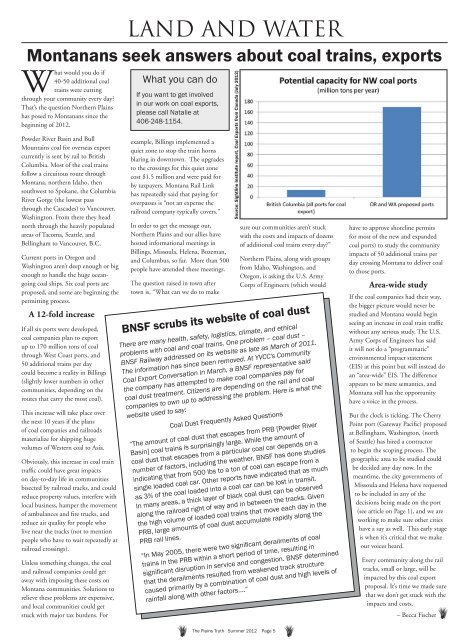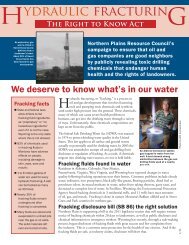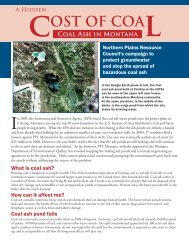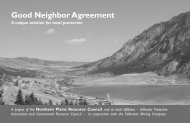Summer - Northern Plains Resource Council
Summer - Northern Plains Resource Council
Summer - Northern Plains Resource Council
Create successful ePaper yourself
Turn your PDF publications into a flip-book with our unique Google optimized e-Paper software.
What would you do if<br />
40-50 additional coal<br />
trains were cutting<br />
through your community every day?<br />
That’s the question <strong>Northern</strong> <strong>Plains</strong><br />
has posed to Montanans since the<br />
beginning of 2012.<br />
Powder River Basin and Bull<br />
Mountains coal for overseas export<br />
currently is sent by rail to British<br />
Columbia. Most of the coal trains<br />
follow a circuitous route through<br />
Montana, northern Idaho, then<br />
southwest to Spokane, the Columbia<br />
River Gorge (the lowest pass<br />
through the Cascades) to Vancouver,<br />
Washington. From there they head<br />
north through the heavily populated<br />
areas of Tacoma, Seattle, and<br />
Bellingham to Vancouver, B.C.<br />
Current ports in Oregon and<br />
Washington aren’t deep enough or big<br />
enough to handle the huge oceangoing<br />
coal ships. Six coal ports are<br />
proposed, and some are beginning the<br />
permitting process.<br />
A 12-fold increase<br />
If all six ports were developed,<br />
coal companies plan to export<br />
up to 170 million tons of coal<br />
through West Coast ports, and<br />
50 additional trains per day<br />
could become a reality in Billings<br />
(slightly lower numbers in other<br />
communities, depending on the<br />
routes that carry the most coal).<br />
This increase will take place over<br />
the next 10 years if the plans<br />
of coal companies and railroads<br />
materialize for shipping huge<br />
volumes of Western coal to Asia.<br />
Obviously, this increase in coal train<br />
traffic could have great impacts<br />
on day-to-day life in communities<br />
bisected by railroad tracks, and could<br />
reduce property values, interfere with<br />
local business, hamper the movement<br />
of ambulances and fire trucks, and<br />
reduce air quality for people who<br />
live near the tracks (not to mention<br />
people who have to wait repeatedly at<br />
railroad crossings).<br />
Unless something changes, the coal<br />
and railroad companies could get<br />
away with imposing these costs on<br />
Montana communities. Solutions to<br />
relieve these problems are expensive,<br />
and local communities could get<br />
stuck with major tax burdens. For<br />
Land and water<br />
Montanans seek answers about coal trains, exports<br />
What you can do<br />
If you want to get involved<br />
in our work on coal exports,<br />
please call Natalie at<br />
406-248-1154.<br />
example, Billings implemented a<br />
quiet zone to stop the train horns<br />
blaring in downtown. The upgrades<br />
to the crossings for this quiet zone<br />
cost $1.5 million and were paid for<br />
by taxpayers. Montana Rail Link<br />
has repeatedly said that paying for<br />
overpasses is “not an expense the<br />
railroad company typically covers.”<br />
In order to get the message out,<br />
<strong>Northern</strong> <strong>Plains</strong> and our allies have<br />
hosted informational meetings in<br />
Billings, Missoula, Helena, Bozeman,<br />
and Columbus, so far. More than 500<br />
people have attended these meetings.<br />
The question raised in town after<br />
town is, “What can we do to make<br />
sure our communities aren’t stuck<br />
with the costs and impacts of dozens<br />
of additional coal trains every day?”<br />
<strong>Northern</strong> <strong>Plains</strong>, along with groups<br />
from Idaho, Washington, and<br />
Oregon, is asking the U.S. Army<br />
Corps of Engineers (which would<br />
BNSF scrubs its website of coal dust<br />
There are many health, safety, logistics, climate, and ethical<br />
problems with coal and coal trains. One problem – coal dust –<br />
BNSF Railway addressed on its website as late as March of 2011.<br />
The information has since been removed. At YVCC's Community<br />
Coal Export Conversation in March, a BNSF representative said<br />
the company has attempted to make coal companies pay for<br />
coal dust treatment. Citizens are depending on the rail and coal<br />
companies to own up to addressing the problem. Here is what the<br />
website used to say:<br />
Source: Sightline Institute report, Coal Exports from Canada (July 2012)<br />
Coal Dust Frequently Asked Questions<br />
“The amount of coal dust that escapes from PRB [Powder River<br />
Basin] coal trains is surprisingly large. While the amount of<br />
coal dust that escapes from a particular coal car depends on a<br />
number of factors, including the weather, BNSF has done studies<br />
indicating that from 500 lbs to a ton of coal can escape from a<br />
single loaded coal car. Other reports have indicated that as much<br />
as 3% of the coal loaded into a coal car can be lost in transit.<br />
In many areas, a thick layer of black coal dust can be observed<br />
along the railroad right of way and in between the tracks. Given<br />
the high volume of loaded coal trains that move each day in the<br />
PRB, large amounts of coal dust accumulate rapidly along the<br />
PRB rail lines.<br />
“In May 2005, there were two signifi cant derailments of coal<br />
trains in the PRB within a short period of time, resulting in<br />
signifi cant disruption in service and congestion. BNSF determined<br />
that the derailments resulted from weakened track structure<br />
caused primarily by a combination of coal dust and high levels of<br />
rainfall along with other factors….”<br />
have to approve shoreline permits<br />
for most of the new and expanded<br />
coal ports) to study the community<br />
impacts of 50 additional trains per<br />
day crossing Montana to deliver coal<br />
to those ports.<br />
Area-wide study<br />
If the coal companies had their way,<br />
the bigger picture would never be<br />
studied and Montana would begin<br />
seeing an increase in coal train traffic<br />
without any serious study. The U.S.<br />
Army Corps of Engineers has said<br />
it will not do a “programmatic”<br />
environmental impact statement<br />
(EIS) at this point but will instead do<br />
an “area-wide” EIS. The difference<br />
appears to be mere semantics, and<br />
Montana still has the opportunity<br />
have a voice in the process.<br />
But the clock is ticking. The Cherry<br />
Point port (Gateway Pacific) proposed<br />
at Bellingham, Washington, (north<br />
of Seattle) has hired a contractor<br />
to begin the scoping process. The<br />
geographic area to be studied could<br />
be decided any day now. In the<br />
meantime, the city governments of<br />
Missoula and Helena have requested<br />
to be included in any of the<br />
decisions being made on the port<br />
(see article on Page 1), and we are<br />
working to make sure other cities<br />
have a say as well. This early stage<br />
is when it’s critical that we make<br />
our voices heard.<br />
Every community along the rail<br />
tracks, small or large, will be<br />
impacted by this coal export<br />
proposal. It’s time we made sure<br />
that we don’t get stuck with the<br />
impacts and costs.<br />
– Becca Fischer<br />
The <strong>Plains</strong> Truth <strong>Summer</strong> 2012 Page 5





